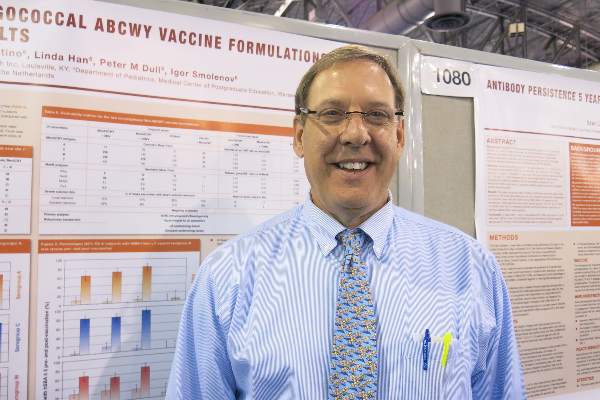User login
PHILADELPHIA – An investigational meningococcal vaccine that covers the five predominant serogroups, including serogroup B, showed early promise in a phase II study in adolescents and young adults.
“As a pediatrician giving shots all day long, giving kids the quadrivalent vaccine and a monovalent serogroup B vaccine at two separate time points can be a real challenge. This combination vaccine gets around that problem by combining all five serogroups,” Dr. Stanley Block said in an interview at an annual scientific meeting on infectious diseases.
Two quadrivalent polysaccharide-protein conjugate meningococcal vaccines against serogroups A, C, W, and Y are available including Menveo from study sponsor, Novartis. It uses the mutated diphtheria toxin, CRM₁₉₇, as a carrier protein (MenACWY-CRM), and is licensed in the United States for persons aged 2 months to 55 years.
Novartis’ serogroup B vaccine, Bexsero (4CMenB), is licensed for use in Europe, Canada, and Australia, but was rejected in the United Kingdom and is being evaluated under fast track designation in the United States. It consists of three recombinant membrane-bound proteins and one outer membrane vesicle (OMV) protein from a New Zealand serogroup B strain, explained Dr. Block, who is a pediatrician in private practice and also works with Kentucky Pediatric and Adult Research in Bardstown, Ky.
The phase II, investigator-blinded study randomly assigned 480 participants, aged 10-25 years, to experimental MenABCWY plus full dose OMV, experimental MenABCWY plus one-quarter dose OMV, MenACWY-CRM plus a placebo vaccination, or 4CMenB. The vaccines were given as a 2-dose series at 0 and 2 months. The per-protocol immunogenicity analysis included 343 participants.
As expected, the percentage of participants with seroresponses against serogroups A, C, W, and Y was notably higher after two doses of combination MenABCWY with full OMV or quarter OMV than after a single dose of the licensed MenACWY-CRM vaccine, Dr. Block reported. Seroresponses were: 90% and 92% vs. 73% for A, 95% and 93% vs. 63% for C, 80% and 84% vs. 65% for W, and 92% and 90% vs. 75% for Y, respectively, likely demonstrating no MenB component interference.
Dr. Block noted that a single dose of MenACWY-CRM vaccine is currently the standard dosage given to all 11- and 12-year-olds, although studies from the Centers for Disease Control and Prevention suggest that immune protection from a single dose may wane after several years.
Two doses of 4CMenB in the study induced immune responses against serogroups A (90%), C (57%), and W (86%), but not against serogroup Y (18%). The 4CMenB vaccine may contribute immune protection against other serotypes because, unlike the polysaccharides in the ACWY conjugate vaccines, the 4CMenB proteins are not unique to a single serogroup, the authors noted in the poster.
Both MenABCWY formulations stimulated robust immune responses to four distinct serogroup B test strains, but they were less than those elicited by the licensed 4CMenB vaccine. This pattern was true regardless of whether response was measured as percentage of subjects with a human serum bactericidal activity titer ≥ 5 or by geometric mean titers.
No overall difference was seen between the MenABCWY formulations in terms of reactogenicity or safety profile, Dr. Block said. Ten serious adverse events were reported by nine subjects, but none were thought to be related to vaccination. The OMV-containing MenABCWY groups, however, had higher frequencies of local reactions, myalgia, and arthralgia.
A phase III trial is being planned, but it is unclear which MenABCWY formulation will be selected for testing, he said at the combined annual meetings of the Infectious Diseases Society of America, the Society for Healthcare Epidemiology of America, the HIV Medicine Association, and the Pediatric Infectious Diseases Society.
PHILADELPHIA – An investigational meningococcal vaccine that covers the five predominant serogroups, including serogroup B, showed early promise in a phase II study in adolescents and young adults.
“As a pediatrician giving shots all day long, giving kids the quadrivalent vaccine and a monovalent serogroup B vaccine at two separate time points can be a real challenge. This combination vaccine gets around that problem by combining all five serogroups,” Dr. Stanley Block said in an interview at an annual scientific meeting on infectious diseases.
Two quadrivalent polysaccharide-protein conjugate meningococcal vaccines against serogroups A, C, W, and Y are available including Menveo from study sponsor, Novartis. It uses the mutated diphtheria toxin, CRM₁₉₇, as a carrier protein (MenACWY-CRM), and is licensed in the United States for persons aged 2 months to 55 years.
Novartis’ serogroup B vaccine, Bexsero (4CMenB), is licensed for use in Europe, Canada, and Australia, but was rejected in the United Kingdom and is being evaluated under fast track designation in the United States. It consists of three recombinant membrane-bound proteins and one outer membrane vesicle (OMV) protein from a New Zealand serogroup B strain, explained Dr. Block, who is a pediatrician in private practice and also works with Kentucky Pediatric and Adult Research in Bardstown, Ky.
The phase II, investigator-blinded study randomly assigned 480 participants, aged 10-25 years, to experimental MenABCWY plus full dose OMV, experimental MenABCWY plus one-quarter dose OMV, MenACWY-CRM plus a placebo vaccination, or 4CMenB. The vaccines were given as a 2-dose series at 0 and 2 months. The per-protocol immunogenicity analysis included 343 participants.
As expected, the percentage of participants with seroresponses against serogroups A, C, W, and Y was notably higher after two doses of combination MenABCWY with full OMV or quarter OMV than after a single dose of the licensed MenACWY-CRM vaccine, Dr. Block reported. Seroresponses were: 90% and 92% vs. 73% for A, 95% and 93% vs. 63% for C, 80% and 84% vs. 65% for W, and 92% and 90% vs. 75% for Y, respectively, likely demonstrating no MenB component interference.
Dr. Block noted that a single dose of MenACWY-CRM vaccine is currently the standard dosage given to all 11- and 12-year-olds, although studies from the Centers for Disease Control and Prevention suggest that immune protection from a single dose may wane after several years.
Two doses of 4CMenB in the study induced immune responses against serogroups A (90%), C (57%), and W (86%), but not against serogroup Y (18%). The 4CMenB vaccine may contribute immune protection against other serotypes because, unlike the polysaccharides in the ACWY conjugate vaccines, the 4CMenB proteins are not unique to a single serogroup, the authors noted in the poster.
Both MenABCWY formulations stimulated robust immune responses to four distinct serogroup B test strains, but they were less than those elicited by the licensed 4CMenB vaccine. This pattern was true regardless of whether response was measured as percentage of subjects with a human serum bactericidal activity titer ≥ 5 or by geometric mean titers.
No overall difference was seen between the MenABCWY formulations in terms of reactogenicity or safety profile, Dr. Block said. Ten serious adverse events were reported by nine subjects, but none were thought to be related to vaccination. The OMV-containing MenABCWY groups, however, had higher frequencies of local reactions, myalgia, and arthralgia.
A phase III trial is being planned, but it is unclear which MenABCWY formulation will be selected for testing, he said at the combined annual meetings of the Infectious Diseases Society of America, the Society for Healthcare Epidemiology of America, the HIV Medicine Association, and the Pediatric Infectious Diseases Society.
PHILADELPHIA – An investigational meningococcal vaccine that covers the five predominant serogroups, including serogroup B, showed early promise in a phase II study in adolescents and young adults.
“As a pediatrician giving shots all day long, giving kids the quadrivalent vaccine and a monovalent serogroup B vaccine at two separate time points can be a real challenge. This combination vaccine gets around that problem by combining all five serogroups,” Dr. Stanley Block said in an interview at an annual scientific meeting on infectious diseases.
Two quadrivalent polysaccharide-protein conjugate meningococcal vaccines against serogroups A, C, W, and Y are available including Menveo from study sponsor, Novartis. It uses the mutated diphtheria toxin, CRM₁₉₇, as a carrier protein (MenACWY-CRM), and is licensed in the United States for persons aged 2 months to 55 years.
Novartis’ serogroup B vaccine, Bexsero (4CMenB), is licensed for use in Europe, Canada, and Australia, but was rejected in the United Kingdom and is being evaluated under fast track designation in the United States. It consists of three recombinant membrane-bound proteins and one outer membrane vesicle (OMV) protein from a New Zealand serogroup B strain, explained Dr. Block, who is a pediatrician in private practice and also works with Kentucky Pediatric and Adult Research in Bardstown, Ky.
The phase II, investigator-blinded study randomly assigned 480 participants, aged 10-25 years, to experimental MenABCWY plus full dose OMV, experimental MenABCWY plus one-quarter dose OMV, MenACWY-CRM plus a placebo vaccination, or 4CMenB. The vaccines were given as a 2-dose series at 0 and 2 months. The per-protocol immunogenicity analysis included 343 participants.
As expected, the percentage of participants with seroresponses against serogroups A, C, W, and Y was notably higher after two doses of combination MenABCWY with full OMV or quarter OMV than after a single dose of the licensed MenACWY-CRM vaccine, Dr. Block reported. Seroresponses were: 90% and 92% vs. 73% for A, 95% and 93% vs. 63% for C, 80% and 84% vs. 65% for W, and 92% and 90% vs. 75% for Y, respectively, likely demonstrating no MenB component interference.
Dr. Block noted that a single dose of MenACWY-CRM vaccine is currently the standard dosage given to all 11- and 12-year-olds, although studies from the Centers for Disease Control and Prevention suggest that immune protection from a single dose may wane after several years.
Two doses of 4CMenB in the study induced immune responses against serogroups A (90%), C (57%), and W (86%), but not against serogroup Y (18%). The 4CMenB vaccine may contribute immune protection against other serotypes because, unlike the polysaccharides in the ACWY conjugate vaccines, the 4CMenB proteins are not unique to a single serogroup, the authors noted in the poster.
Both MenABCWY formulations stimulated robust immune responses to four distinct serogroup B test strains, but they were less than those elicited by the licensed 4CMenB vaccine. This pattern was true regardless of whether response was measured as percentage of subjects with a human serum bactericidal activity titer ≥ 5 or by geometric mean titers.
No overall difference was seen between the MenABCWY formulations in terms of reactogenicity or safety profile, Dr. Block said. Ten serious adverse events were reported by nine subjects, but none were thought to be related to vaccination. The OMV-containing MenABCWY groups, however, had higher frequencies of local reactions, myalgia, and arthralgia.
A phase III trial is being planned, but it is unclear which MenABCWY formulation will be selected for testing, he said at the combined annual meetings of the Infectious Diseases Society of America, the Society for Healthcare Epidemiology of America, the HIV Medicine Association, and the Pediatric Infectious Diseases Society.
AT IDWEEK 2014
Key clinical point: An experimental meningococcal vaccine that targets all five serogroups A, C, W, Y, and B could reduce the need for two separate vaccines.
Major finding: The percentage of participants with seroresponses against serogroups A, C, W, and Y was higher after two doses of experimental MenABCWY than after a single dose of the licensed MenACWY-CRM vaccine.
Data source: Phase II study in 480 healthy 10- to 25-year-olds.
Disclosures: Novartis Vaccines sponsored the study. Dr. Block reported serving as an investigator for Novartis. Several coauthors are Novartis employees.

